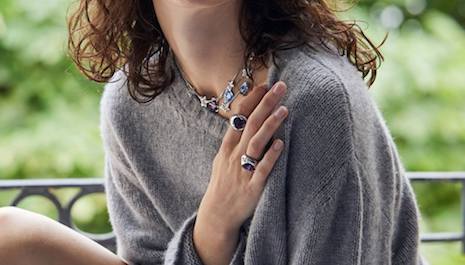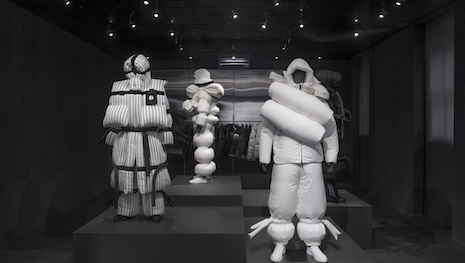 Baccarat's jewelry line designed by Lorenz Baumer. Image credit: Baccarat
Baccarat's jewelry line designed by Lorenz Baumer. Image credit: Baccarat
HONG KONG – Entering creative partnerships can help brands venture into new categories or modernize their image, but luxury labels need to keep their DNA at the heart of collaborations.
From mashups between external designers and heritage houses to a meeting of two likeminded brands, working with other parties provides the means for labels to showcase a different side of themselves and achieve newness. During a panel discussion at the New York Times International Luxury Conference on Nov. 12, speakers pointed out that these partnerships can change how a brand is perceived while also drumming up buzz and business.
"I feel brand perception is one of the most important things," said Remo Ruffini, CEO of Moncler. "If you want to keep your brand strong, you have to be able to talk with the consumer."
Collaborate and listen
Moncler has been on a transformation process this year. After parting ways with its in-house runway collection designers, the brand launched a collaborative series with eight designers (see story).
Moncler worked with Ssense for a Genius exhibit. Image credit: Ssense
Dubbed Genius, the project is aimed at giving Moncler more to say to its customer, according to Mr. Ruffini.
Coming from a different perspective, Baccarat does not employ an in-house designer. The house’s CEO Daniela Riccardi explained that collaborations enable it to infuse its products with outside aesthetics, while also allowing it to move into new, unexpected categories.
For instance, the crystal label recently teamed with footwear designer Diego Dolcini on a line of crystal-adorned shoes. It has also collaborated on jewelry collections.
Nike recently entered into a collaboration aimed at female sneakerheads, inviting a group of young women to reinterpret its sports-focused footwear.
According to the brand’s chief design officer John Hoke III, collaboration allows the brand to do things it could not do itself.
For instance, through working with Virgil Abloh, Nike was able to tap into some new materials that it otherwise would not have been able to use.
Nike collaboration with Virgil Abloh. Image credit: Nike
Moderator and New York Times business reporter Emily Steel asked the panelists if their collaborative endeavors have achieved business goals as well as driving attention.
Ms. Riccardi said that for Baccarat, partnerships are about both branding and sales, while Mr. Ruffini focuses less on the numbers and more on strengthening the Moncler brand.
Part of brand building comes through listening to luxury buyers. The panelists agree that brands need to be keeping up a daily dialogue with consumers.
Nike’s Mr. Hoke said that rather than thinking of conversing with the customer as broadcasting, brands should instead focus on a two-way engagement.
As with many other luxury brands, the speakers are looking to tap into the next generations of luxury consumers.
From listening to millennials, Ms. Riccardi said that often it is not about making products specifically for them, but about presenting them differently.
From left, Remo Ruffini, Daniela Riccardi and John Hoke III with moderator Emily Steel
Nike’s Mr. Hoke envisions brands as being more than just buying platforms, with the addition of co-creation. This allows labels to engage with customers on a one-to-one basis.
Sneaking into sneakers
As the sneaker market continues to grow, a number of brands have launched footwear partnerships surrounding the athletic shoe.
For instance, Condé Nast’s Vogue magazine joined fashion and sporty footwear through a partnership with sneaker brand Jordan.
The publication teamed with the sneaker label to release two new reimagined versions of its Air Jordan style, marking the Nike brand’s first women’s collaboration. While sneakers were formerly considered a functional rather than fashionable footwear choice, they have increasingly been embraced as a stylish option (see story).
Fashion designer Karl Lagerfeld similarly went off the wall via a collaboration with Californian skateboard shoe brand Vans.
Mr. Lagerfeld designs for three full-time labels—his namesake line, Chanel and Fendi—in addition to working on a number of hobby projects such as photography, lending his skills to fashion houses and international magazines. For the Karl Lagerfeld label, the designer often collaborates with other brands to enter new product categories including cosmetics, hospitality and now sneakers (see story).
Even with these collaborative sneakers and brands launching their own in-house styles of the shoes, Mr. Hoke does not see luxury athletic shoes as a threat, since Nike is about beautifying the science of movement. Whereas its own sneakers are used by athletes in competition, luxury shoes tend to lead with fashion and have not made it onto the field.
"The world of active life is beginning to grow, and grow in different segments," Mr. Hoke said. "So it gives us more artistic and stylistic freedom to keep pushing this beautiful utility for her and for him so that we balance that form and function."


